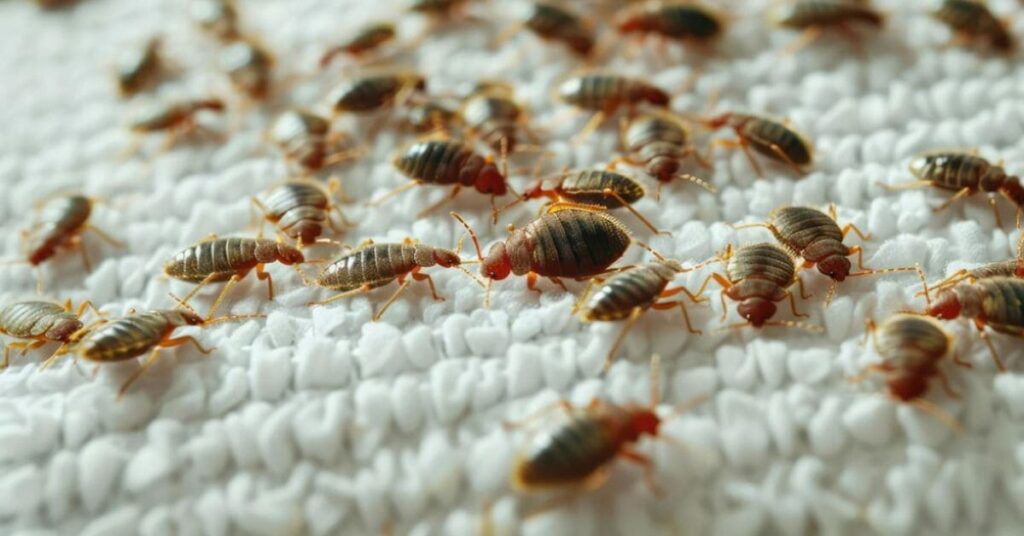Yes, you can see bed bugs during the day, although they are primarily nocturnal insects. While bed bugs prefer to remain hidden during daylight hours to avoid detection and potential threats, they may still be visible under certain circumstances.
Behavior Patterns:
Since they are mostly nighttime organisms, bed bugs are most active at night when their victims are asleep. However, depending on a number of variables, bed bugs may display unique behaviors throughout the day. Even though they usually hide in cracks, crevices, and other remote places to avoid being discovered, they could still move around if their hiding places are violated or they are disturbed.
Bed bugs are drawn into the carbon dioxide Humans release their breath, body heat, and other chemical signals, which usually lead them to appear from hiding to feed during the night. During the day, they usually stay hidden to avoid light and human activity. However, in cases of severe infestations or if they are actively searching for a new host, bed bugs might be more visible during daylight hours.
Visibility Factors:
Several factors impact the visibility of bed bugs during the day. One critical factor is the harshness of the infestation. In the early stages of an infestation, bed bugs may remain hidden most of the time, making them less likely to be seen during daylight hours. However, as the infestation progresses and the bed bug population increases, it becomes more probable to encounter them during the day.
Another factor is disturbance. Bed bugs may come out during the day to find new hosts or hiding locations if their hiding places are disturbed, either purposefully by examination or accidentally by moving furniture or bedding.
This disturbance can temporarily disrupt their nocturnal habits, leading to increased visibility.
Hiding Habits:
Bed bugs are able to find hiding spots that offer protection and easy access to their hosts for feeding. During the day, bed bugs typically retreat to secluded areas near their feeding sites, where they can remain undisturbed until they feel the chance to
feed again.
Common hiding places include:
mattresses and box springs: Bed bugs often hide in seams, folds, and crevices of mattresses and box springs, close to where their human hosts sleep.
- Furniture: They may also hide in or around furniture, such as bed frames, nightstands, sofas, and chairs, especially if these items are located near sleeping areas.
- Baseboards and Wall Junctions: Cracks and gaps in baseboards, as well as areas where walls meet the floor or ceiling, provide ideal hiding spots for bed bugs.
- Electrical Outlets and Switch Plates: Bed bugs can squeeze into tiny spaces, including gaps around electrical outlets and behind switch plates.
- Clothing and Clutter: Piles of clothing, clutter, and other items in bedrooms and living areas offer additional hiding places for bed bugs.
- Luggage and Backpacks: Bed bugs can hitch a ride in luggage, backpacks, and other belongings, potentially introducing them to new environments.
Feeding Cycles:
Bed bugs have unique feeding cycles that can impact their visibility during the day. Bed bugs are typically attracted to human body heat and carbon dioxide during the night when their hosts are sleeping. After feeding, bed bugs retreat to their hiding spots to digest the blood meal and mate.
- Early Infestations: In the early stages of an infestation, bed bugs may display more unpredictable behavior, including increased activity during the day as they establish their colony and search for suitable hiding spots.
- Hunger: If bed bugs are unable to feed regularly due to a lack of hosts or other factors, they may become more active during daylight hours in search of a blood meal. This behavior is more likely to occur in heavily infested areas where hosts are scarce.
- Disturbance: Bed bugs may appear during the day if their hiding spots are disturbed, either by human activity or pest control interventions. This disruption to their normal feeding cycle can temporarily alter their behavior and make them more visible.
- Human Interaction: Human activity can play a significant role in coming across bed bugs during the day. While bed bugs are primarily nocturnal, certain actions or routines can inadvertently disturb them, leading to daytime sightings. Some common scenarios where people may come into contact with bed bugs during the day include:
Cleaning and Moving Furniture: Bed bugs may emerge throughout the day in search of new harborages if their hiding places are disturbed by actions like vacuuming, moving furniture, or rearranging goods in afflicted areas.
Changing Bedding: Mattresses, box springs, and bed frames are common places for bed bugs to hide. People may unknowingly excite bed bugs when changing bedding or doing basic maintenance on bedding materials, making them visible all day.
Travel and Commuting: Bed bugs have the ability to travel to new areas by hitching a ride on clothing, luggage, and other personal items. When unpacking bags after traveling or commuting, people may come across bed bugs during the day, especially if they have stayed in infested lodgings or taken public transportation.
Workplace Environments: There is a chance that employees in jobs like housekeeping, hospitality, and healthcare will come into contact with bed bugs on a daily basis. The danger of exposure is increased for workers in these occupations because they may handle bed bug-infected objects or come into contact with infested settings.
Social Gatherings: Sharing possessions with infected people or visiting homes that are infested are two ways that bed bugs can spread through social interactions. Bed bugs can be encountered during the day if one attends social gatherings or activities where they are prevalent.
People can reduce their chance of coming into contact with bed bugs during the day and prevent infestations by being aware of these possible sites of interaction. There are steps you may take to lessen the chance of coming into contact with bed bugs, like routine cleaning, examining used objects before bringing them into the house, and exercising caution when traveling.


